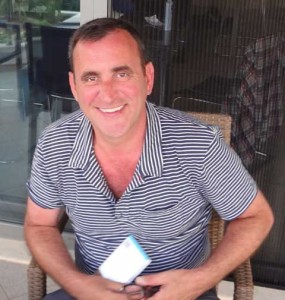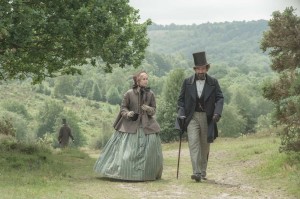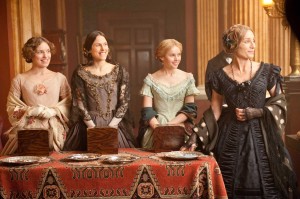
Costume designer Michael O’Connor is a veteran of period costume films, after all, he has received an Academy Award nomination in 2012 for his work in Jane Eyre and a win in 2009 for The Duchess.
In director Ralph Fiennes‘ The Invisible Woman the tale of Charles Dickens‘ (Fiennes) secret love affair with a young woman, Nelly Ternan (Felicity Jones) is told. Michael O’Connor dressed the characters in garments as lavish and dramatic as the main character’s clandestine relationship.
The details occupied O’Connor’s mind at every step. He had three months to prepare for the film and he spent his time reading Dickens’ books and biographies, strolling through the Victoria and Albert museum with the director, looking at original photographs of Dickens, Ternan and the other characters. Dickens loved being photographed, so fortunately many photographs of him and the other characters existed. “[It took] quite a long time doing the research. They’re real people so we researched the real clothes that they wore,” the costume designer said.

O’Connor found the perfect collaboration with Fiennes. “Ralph is interested in the details because that’s what makes the characters. He will give you so much time for the costumes and the way things look,” he said. “He’s very visual. He really wants to look at the small details with the big picture as well.”
From the research, a color palette was selected. “With Nelly we started her out with dull colors, with grays, with muted things to keep her in the background. She didn’t want to shine out for the beginning of the film,” O’Connor explained. The character of Dickens did not depend so much on a color palette as much as the exquisite details in his costumes. “It was more about how far to take Dickens into the showman or into the man – the real man himself behind the show scene. So the conversation [with the director] was about how big the pattern could be on a waistcoat, how wild the pattern could be, or how subtle things needed to be for a particular more intimate scene.”
 Time also played a large role in determining the details of the costumes. The film stretches through the length of Dickens’ life so O’Connor always took time into consideration as he planned each look. “The time goes over a while with Dickens being a dandy in the 1830s to turning into a man who wore gray suits in the 1860s so I wanted to get that timeline in,” O’Connor said. “There’s some strong Victorian colors, like jewel colors, dark blues, reds and then we go off to grays, and then he’s in France so it’s more linen type clothing.”
Time also played a large role in determining the details of the costumes. The film stretches through the length of Dickens’ life so O’Connor always took time into consideration as he planned each look. “The time goes over a while with Dickens being a dandy in the 1830s to turning into a man who wore gray suits in the 1860s so I wanted to get that timeline in,” O’Connor said. “There’s some strong Victorian colors, like jewel colors, dark blues, reds and then we go off to grays, and then he’s in France so it’s more linen type clothing.”
Weaving the details of The Invisible Woman together was a task O’Connor was grateful to be a part of. “I’m a massive fan of Dickens so I was really enthusiastic to do a film that portrayed him.”





